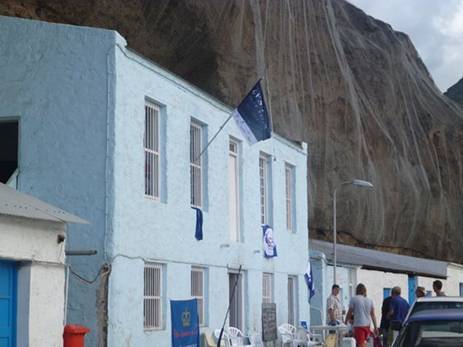For when the Saints, come marching in ........

Monday January 27th, 2014 South Atlantic Ocean, 11 48.4S 10 22.7W Today's Blog by David (Time zone: UTC) We left St Helena very early on Saturday morning. We are now making good progress towards Ascension Island and expect to get there on Wednesday. The weather is surprisingly cold and wet, considering we are at 12 degrees South. At 12 degrees North, in January, the conditions would be stiflingly hot and humid - yet we are putting warm clothes on at night and have been since we left Cape Town (it is mid-summer there – its latitude is similar to Gibraltar). I guess the knowledge that it is not ‘t-shirts at night’ weather on board is of little consolation to those of our readers who still remain, having not yet been washed away or frozen out this winter! St Helena What a lovely place! There are about 4,200 permanent residents and another fair few visitors principally building the new airport. 900 of these live in Jamestown – the capital. These residents are referred to as “Saints”. Their bloodline is about as varied as I have seen: a mixture of European, Chinese, African and Indian - interbred over the last 300 years. Their language is said to be English but you could be forgiven for doubting that when listening to a conversation between two Saints. In conversation with visitors, the women have a pretty, lilting accent, very easy on the ear; the men are, frankly, unintelligible. The island is a(nother) volcanic outcrop – measuring about 8 miles by four. >From the sea it looks dull, barren and brown 9as do most other volcanic islands). There are military bunkers, pill boxes etc. surrounding every feasible anchorage or landing place – a reflection of the islands strategic value over the years. On the dockside is the Yacht Club:
All of the cliffs around the north of the harbour are being “stabilised” by a covering of (EU Grant funded) wire mesh, similar to that which retains the hillsides around European skiing locations. Peter enjoyed the Islands principal tourist attraction: known as ‘Jacob’s Ladder’. This comprises a flight of 699 steps - each with a rise of 11 inches – up the cliff face between the main town and the fort and houses on the cliff top. He walked up and down …… and even got a certificate to prove it! As I have said, the town looks much as it did 200 years ago. Replace the tarmac with dirt and remove the cars in this photo and you can imagine what it must have been like:
The population lives in a time-warp. Telecommunications are probably 15 years behind the UK – no mobile phone network and a 126kbit internet service – for those with a landline installed! The economy is subsidised by HMG to the tune of £10m per annum PLUS a further £5m to fund the ship that runs between Ascension Island (where there is a military plane service) and occasionally Cape Town. That ship (the Royal Mail Ship/service (RMS)) is presently the only passenger route to St Helena – in or out. It is also the source of all fresh food and other goods that are not produced on the island. The interior – once you get above about 1,000 feet is lush and green – with separate microclimates as you round each corner. The main trade on the island, years ago, was the production of flax – pretty much the whole island was devoted to it – supplying the production of sails and other cloths and most recently Royal Mail Bags. When l plastics became cheaper and more reliable the St Helena economy was trashed and it took many years to recover. They have dug up the flax farms but it is still a ubiquitous weed – particularly on steep surfaces:
The broadleaved evergreen in the foreground of this picture of Sandy Bay is ‘wild’ flax. On the other side of the road at the same spot the view was of open cattle pasture:
We went to see the house where Napoleon lived and died (that period of history being yet another Black Hole in my History education). Things will change when the airport is built. HMG’s idea is that once the Airport is open we will stop funding the RMS and as tourism increases we will gradually reduce the annual grant. There is no hotel worthy of the name on the island – and less than 100 beds available in guest houses and equivalents. There are already people prospecting for hotel sites. In the short term, local casual labour rates have perhaps doubled with the demand from the airport construction – the hotel construction will continue that demand - but unless there is a sharp influx of tourists, the economy (such as it is) will slump. If there IS an influx of tourists that will help the economy but the very nature of the island will change - not everyone thinks the change will be for the better. In summary, if St Helena is on your ‘Bucket List’ – do it soon, before the airport is scheduled to open towards the end of next year. There are seats available to the public on flights twice a week from RAF Brize Norton to Ascension and then a two day cruise on the RMS to St Helena. The journey alone would be quite an experience! |



